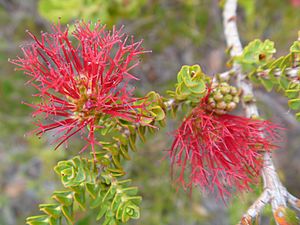Dark beaufortia facts for kids
Quick facts for kids Dark beaufortia |
|
|---|---|
 |
|
| In the Fitzgerald River National Park | |
| Scientific classification | |
| Genus: |
Beaufortia (plant)
|
| Species: |
anisandra
|
| Synonyms | |
|
Melaleuca anisandra (Schauer) Craven & R.D.Edwards |
|
Beaufortia anisandra, also known as dark beaufortia, is a special plant from the myrtle family. This family includes plants like eucalyptus and tea trees. It only grows naturally in the south-west part of Western Australia. It's a bushy plant with lots of branches. Its leaves are shaped like eggs and point upwards. The plant has beautiful flowers that are dark bluish-purple or red. These flowers grow in round clusters. A unique thing about its flowers is that their stamens (the parts that hold pollen) are different lengths. People have also said it has a strong, unusual smell.
Contents
What Does Dark Beaufortia Look Like?
Beaufortia anisandra is a shrub with many branches. It can grow up to about 1.5 meters (5 feet) tall. Its leaves grow in pairs, one across from the other. They are shaped like eggs or narrow spearheads. Each leaf is about 3 to 6.5 millimeters long. They are stiff and curve inwards, like a tiny boat. You can see a main vein in the middle and some faint veins on the sides.
Flowers and Fruits
The flowers of the dark beaufortia are red to dark purplish-red. They grow in round clusters at the ends of the branches. Even after the flowers bloom, the branches keep growing! Each flower has 5 sepals (small leaf-like parts that protect the bud) and 5 petals. It also has 5 groups of stamens. Stamens are the parts of a flower that produce pollen.
A cool thing about these stamens is that they are joined together for most of their length. Only about 3 separate threads stick out from the joined part. Some of these stamen groups can be longer than 19 millimeters (about 0.75 inches). But others in the same flower are much shorter. This difference in stamen length helps us tell this beaufortia apart from others.
Dark beaufortia flowers usually bloom from January to July, or from October to December. After the flowers, the plant produces fruits. These fruits are woody capsules. They are about 8 to 15 millimeters long and 7 to 12 millimeters wide. They often grow in clusters.
A Plant with a Unique Scent
In 1854, a scientist named William Henry Harvey saw this plant at Cape Riche. He wrote about its strong smell. He joked that it would probably make Sir Francis Beaufort happy. Sir Francis Beaufort was known for liking plants that had a strong smell, even if it wasn't a pleasant one!
How Was it Named?
The plant Beaufortia anisandra was first officially described in 1843. This was done by a botanist named Johannes Conrad Schauer. He wrote about it in a scientific paper.
The second part of its name, anisandra, comes from two old Greek words. Anisos means "unequal," and aner means "male." This name refers to the stamens, which are the "male" parts of the flower, being of unequal lengths.
Where Does Dark Beaufortia Grow?
Beaufortia anisandra mostly grows near the towns of Albany and Esperance. These areas are in the biogeographic regions called the Avon Wheatbelt, Esperance Plains, and Jarrah Forest. You can find it growing in sand and rocky soils. It likes hills, rocky outcrops, and flat plains.
Is it Protected?
The Western Australian Government's Department of Parks and Wildlife says that Beaufortia anisandra is "not threatened." This means it is not currently in danger of disappearing.

